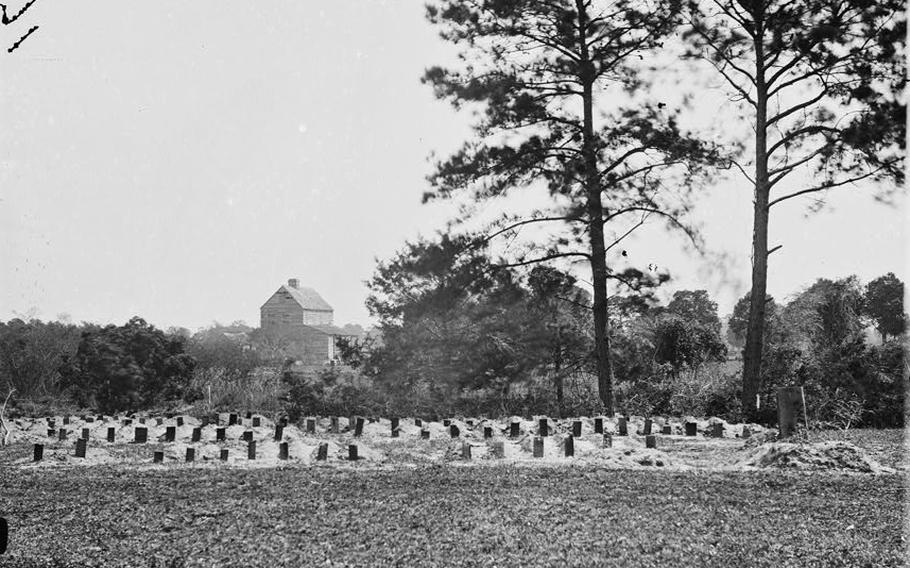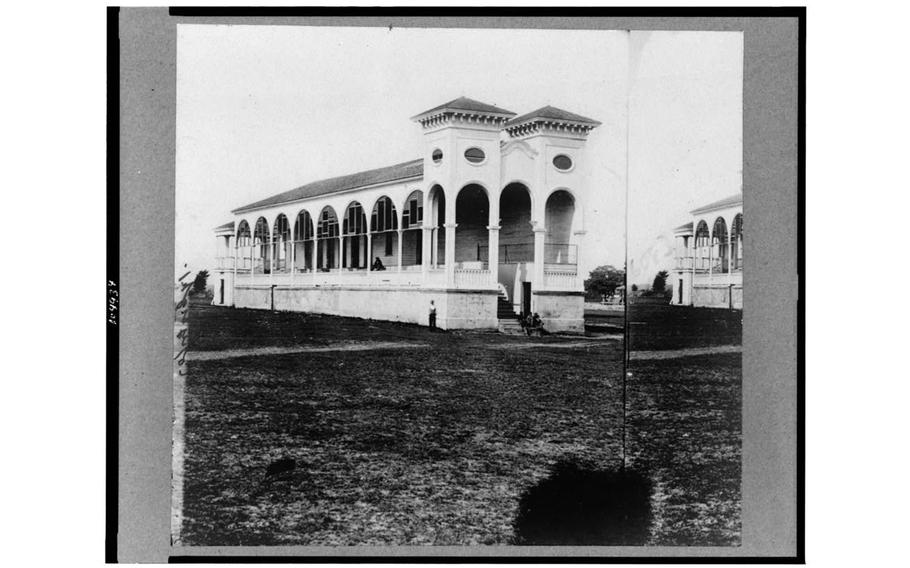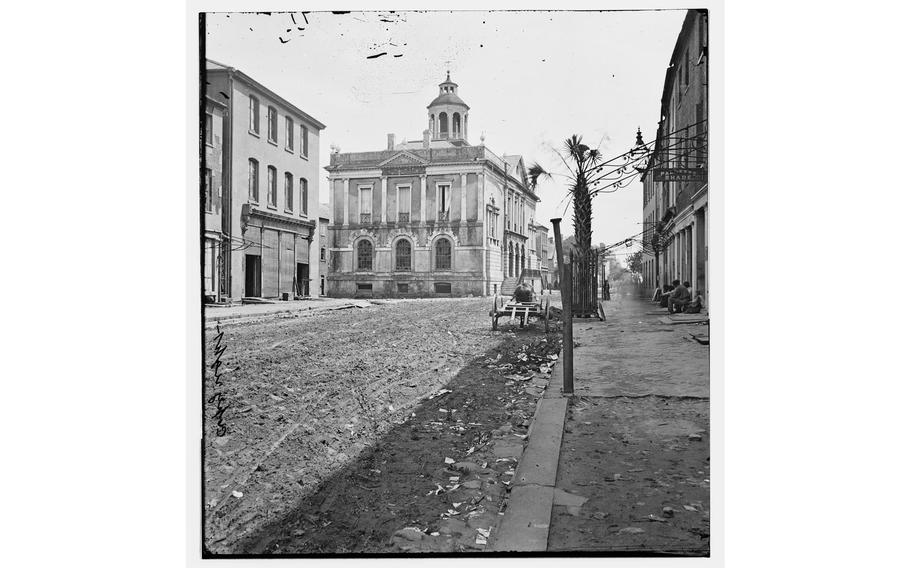
An 1865 photo of the graves of Union soldiers who were buried at the racecourse in Charleston, S.C., during the Civil War. (Library of Congress)
On May 1, 1865, thousands of newly freed Black people gathered in Charleston, S.C., for what may have been the nation's first Memorial Day celebration. Attendees held a parade and put flowers on the graves of Union soldiers who had helped liberate them from slavery.
The event took place three weeks after the Civil War surrender of Confederate Gen. Robert E. Lee and two weeks after the assassination of President Abraham Lincoln. It was a remarkable moment in U.S. history — at the nexus of war and peace, destruction and reconstruction, servitude and emancipation.
But the day would not be remembered as the first Memorial Day. In fact, white Southerners made sure that for more than a century, the day wasn't remembered at all.
It was "a kind of erasure from public memory," said David Blight, a history professor at Yale University.
In February 1865, Confederate soldiers withdrew from Charleston after the Union had bombarded it with offshore cannon fire for more than a year and began to cut off supply lines. The city surrendered to the Union army, leaving a massive population of freed formerly enslaved people.
Also left in the wake of the Confederate evacuation were the graves of more than 250 Union soldiers, buried without coffins behind the judge's stand of the Washington Race Course, a Charleston horse track that had been converted into an outdoor prison for captured Northerners. The conditions were brutal, and most of those who had died succumbed to exposure or disease.
In April, about two dozen of Charleston's freed men volunteered to disinter the bodies and rebury them in rows of marked graves, surrounded by a wooden, freshly whitewashed fence, according to newspaper accounts from the time.
Then, on May 1, about 10,000 people — mostly formerly enslaved people — turned out for a memorial service that the freed people had organized, along with abolitionist and journalist James Redpath and some white missionaries and teachers from the North. Redpath described the day in the New-York Tribune as "such a procession of friends and mourners as South Carolina or the United States never saw before."
The day's events began around 9 a.m. with a parade led by about 2,800 Black schoolchildren, who had just been enrolled in new schools, bearing armfuls of flowers. They marched around the horse track and entered the cemetery gate under an arch with black-painted letters that read "Martyrs of the Race Course." The schoolchildren proceeded through the cemetery and distributed the flowers on the gravesites.
Other attendees entered the cemetery with even more flowers, as the schoolchildren sang songs including "The Star-Spangled Banner" and "John Brown's Body."
"When all had left," Redpath wrote, "the holy mounds — the tops, the sides, and the spaces between them — were one mass of flowers, not a speck of earth could be seen; and as the breeze wafted the sweet perfume from them, outside and beyond, to the sympathetic multitude, there were few eyes among those who knew the meaning of the ceremony that were not dim with tears of joy."

The clubhouse at the Charleston racecourse, where Union officers were confined, in April 1865. (Library of Congress)
The dedication ended with prayers and Bible verses from local Black ministers, followed by speeches from Union officers and Northern missionaries, a picnic on the racecourse and drills by Union infantrymen, including some African American regiments. The observance didn't end until sundown.
And then, Blight said, the event was forgotten. Not right away — but within a few decades, any recollection persisted merely as rumor, in verbal anecdotes.
The reason, he said, is that "by the middle and end of Reconstruction, the Black folks of Charleston were not creating the public memory of that city."
The portrayal of the Civil War and its aftermath was controlled in the South by groups such as the United Daughters of the Confederacy and the Ladies' Memorial Association, as well as Confederate veterans, Blight said.
"The Daughters of the Confederacy were the guardians of that narrative," said Damon Fordham, an adjunct professor of history at The Citadel, a military college in Charleston. "And much of that was skewed toward the Confederate point of view."
Blight chronicled the 1865 Charleston ritual in his 2001 book "Race and Reunion: The Civil War in American Memory," based on evidence that Fordham helped him uncover. Blight had been researching the book in 1999, in an archive of the Houghton Library at Harvard University, when he found a collection of papers written by Union veterans that contained a description of the May 1, 1865, events in Charleston.
If the description was accurate, Blight said, he knew that "that event in Charleston deserves its own full commemoration, just because of the poignancy of it, the sheer scale of it."
But first he had to corroborate it. One of the first places he contacted was the Avery Research Center for African American History and Culture at the College of Charleston. "I called up the curator there," Blight recalled, "and I said, 'I just found this in a collection of veterans materials. Have you ever heard of this story?' And the guy said, 'No. That never happened.'"
The "guy" was Fordham, who at the time was a graduate student at the college and a research assistant at Avery. Despite his doubts, Fordham knew the center had microfilm of the Charleston Courier, a daily newspaper from that time, so he checked it.
"About two hours later, he called me back, and he said, 'Oh my God, here it is,'" Blight said. It was a Courier article from May 2, 1865, "describing this extraordinary parade on the old planters' racecourse."
Blight went on to find more proof, including an illustration of the fenced cemetery that was published in Harper's Weekly in 1867. "Pretty soon I had all these sources that no one had ever bumped into, so one thing kept leading to another," he said. "But even people in Charleston said, 'No, never heard of it.' That shows the power of the erasure of public memory over time."
In the book, Blight describes a 1916 letter written by the president of the Ladies' Memorial Association in Charleston, replying to an inquiry about the May 1, 1865, parade. "A United Daughters of the Confederacy official wanted to know if it was true that blacks and their white abolitionist friends had engaged in such a burial rite," he wrote. "Mrs. S.C. Beckwith responded tersely: 'I regret that I was unable to gather any official information in answer to this.'"
In the 1880s, the bodies of the Union soldiers, the "Martyrs of the Race Course," were exhumed and moved to Beaufort National Cemetery. The horse track closed shortly after that, and the 60 acres of land became Hampton Park, named for Wade Hampton III, a Confederate general and Charleston native who became governor of South Carolina in 1876. Hampton enslaved nearly 1,000 people before the war, and his governorship was supported by the Red Shirts, a white paramilitary group that violently suppressed the Black vote.
By the end of the century, no vestige of the racecourse, the cemetery or the 1865 parade remained.
More spring graveside memorials followed the one in Charleston. Several occurred in towns across the country in the spring of 1866, and many of these places — such as Columbus, Miss., whose commemoration became annual — claim to have held the original Memorial Day observance. Officially, the nation recognizes Memorial Day as having started in Waterloo, N.Y.
In Charleston, the freed people didn't have the power to develop an annual tradition after 1865. But the city now recognizes itself, regardless, as the holiday's birthplace.
"On May 1, 1865, a parade to honor the Union war dead took place here," reads a state historical marker erected in Hampton Park in 2017. "The event marked the earliest celebration of what became known as 'Memorial Day.' "

The Charleston post office in 1865. (Library of Congress)